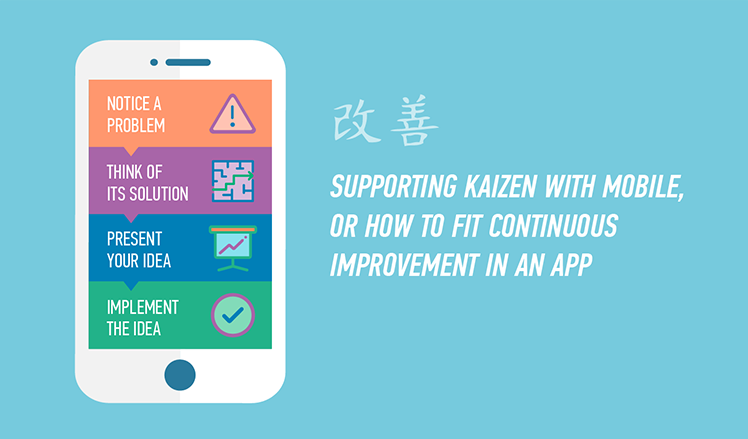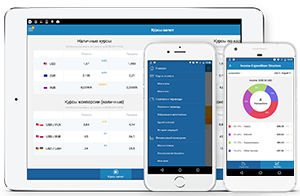‘Kaizen’ is the name of a business improvement methodology that can be literally translated from Japanese as ‘a change for the better’. The kaizen principles were coined by Japanese organizational theorist Masaaki Imai and are renowned for being the basis of the management strategy at Toyota Motor Corporation. Nonetheless, the idea of incremental improvements originated in the US and was introduced to the Japanese by American experts. The idea resonated and helped many Japanese manufacturers to get on their feet after World War II.
Since kaizen is heavily based on employees’ initiative and encourages individual effort, it can foster employee engagement and become one of the cornerstones of effective human resources management (HRM). In this article, our mobile app developers will hit the high spots of this methodology and show how to bring kaizen to mobile.

What is kaizen?
Kaizen suggests to stop thinking about how unattainable perfection is and start acting, one little step at a time. Encouraging employees to come up with small initiatives to make even minor changes that, one by one, will lead to progress – is the key concept of this methodology.
According to kaizen, each and every organization type, be it a production line or an office, has seven muda, or stagnating and counterproductive processes related to inventory (unprocessed materials or stalled projects), transportation (unnecessary relocation of the product), motion (employees’ excessive activity), delay (wasted time), over-processing (unaccountable efforts), over-production (unsold product), and defects (double work).
While literally meaning ‘futility, uselessness’, muda is waste that jams the business gears and prevents companies from advancing. Getting rid of this waste is the fundamental objective of kaizen, and it’s rightfully believed that no one can spot the waste better than employees who are always in the heart of all processes.
How kaizen deals with waste
When a printing machine doesn’t function and people have to go to another floor to use the working one, it’s the waste of motion. It can seem obvious how to fix it in this case, but situations differ. Some problems (especially those concerning routine workflows) have deeper roots and can only be dealt with when noticed, understood and acknowledged. Kaizen nurtures rethinking and reinventing each and every process, inspiring employees contribute to the company’s growth – something many HRM tools cannot achieve.
The order of actions that employees have to make to cope with waste is called a ‘kaizen event’ and consists of 4 steps:
- Noticing and understanding a problem
- Thinking of its solution
- Presenting an idea of an improvement to a manager/supervisor and getting their approval to act
- Implementing the idea
Kaizen events in a mobile app
Though aimed at eliminating unproductivity, a kaizen event itself can cause two wastes at a time: inventory and delay. This happens since ideas of small improvements are communicated to the manager in the form of a ‘kaizen sheet’ (teian ), and these paper sheets may get lost on the manager’s table without any prospect of progress.
Fortunately, mobile software can facilitate the process, speed it up and reduce paperwork. This is how an app can guide through a kaizen event:
-
Classifying the waste with pre-set categories
After acknowledging a problem and understanding its roots (for instance, noticing that two professionals who work on the same project both carry out quality assurance and thus create the waste of over-processing, and suggesting to officially delegate this function to just one of the experts), an employee opens a mobile app and chooses the category the problem fits best: tools or appliances, working environment, schedule, working principles and the like. There is no longer the need to be creative or spend time to come up with the right wording: a mobile app can store all possible variants and combinations of circumstances. If the company has several offices, there can also be an option to specify the location.
-
Filling in a standard form and attaching a picture
Kaizen software can contain questions that will guide an employee through describing how they see the improvement. Simple questions will only require to choose an option (for example, whether or not the solution requires financing, and if yes, what is the approximate budget scope); more detailed ones will provide a text box to type in an answer. To illustrate the issue, the employee can make a photo and attach it to the sheet.
-
Providing prompt feedback
Once a kaizen sheet is created in the mobile app, the employee’s supervisor will immediately receive a notification. By looking through the category tagged in the electronic kaizen sheet, they will quickly catch up with the circumstances and grasp the details described in a standardized way. After getting familiar with the suggested idea, the line manager can provide feedback by pushing the ‘accept’ button, sending a tip or an invitation for a meeting to discuss the problem in detail.
-
Tracking the implementation
Employees can use the mobile app to track the progress and outcomes of implementing the solution whether they are involved in the implementation themselves or initially created a kaizen event. Thus, they will not only keep their management posted, but also record the proceedings for future reference by employees who may face similar issues.
Fostering further initiative
When invited to share their vision on how to improve working processes, employees get to experience ups and downs of business more personally. That way, kaizen helps employees to feel more responsible for all their actions and closely associate themselves with the company’s success, since they don’t just do their assigned jobs but contribute to the business with their own ideas.
The mobile app can be enhanced with push notifications to engage employees in the process of improving the company’s workflows. Employees who rarely take part in kaizen-related activities will get a friendly reminder to contribute to the company’s wellbeing more often. After all, according to kaizen, improvement has no limits.
Conclusion
Kaizen effectively engages employees in making consistent steps on the long way to their company’s improvement and cleaning the dust off the gears, in a way. It is these small, usually easy-to-fix problems that can later lead to bigger issues, so by eliminating even minor hurdles organizations can avoid great ones. Supported with software, kaizen gets more comprehensible, which makes continuous improvement less confusing and more accessible to everyone in the company.

Dealing with a mobile-related challenge? Take advantage of the diverse and deep knowledge of our mobile development team.
